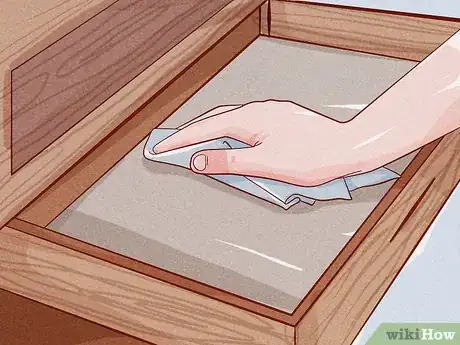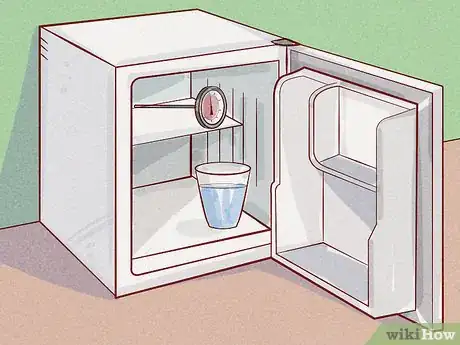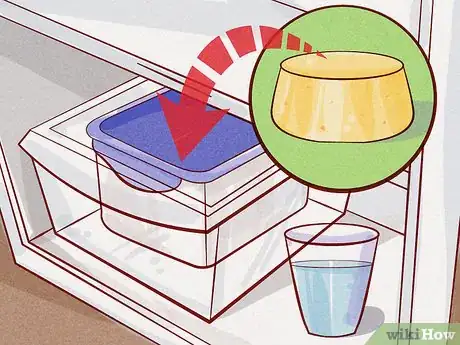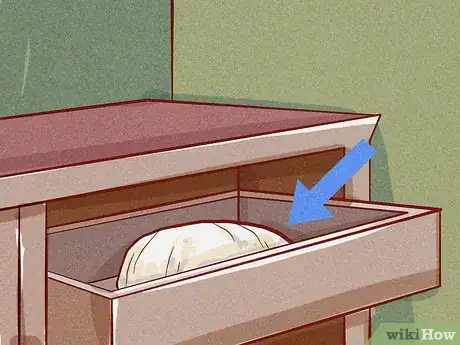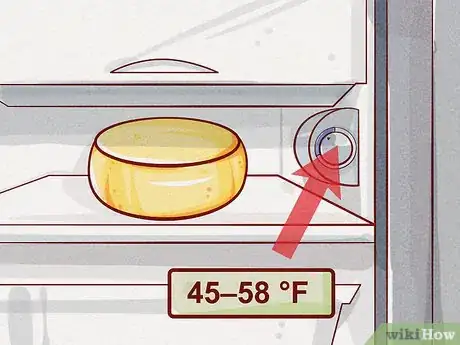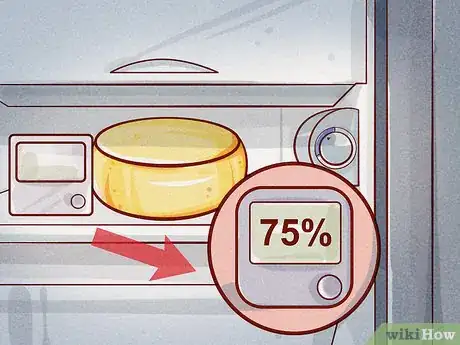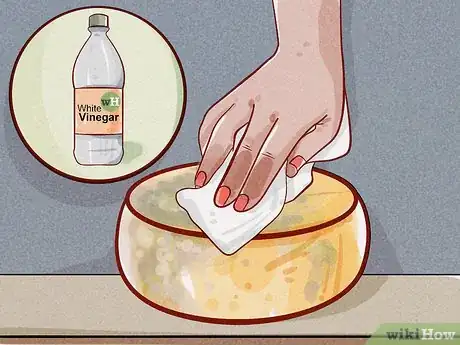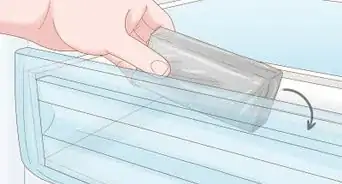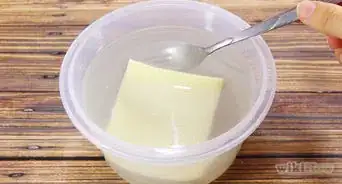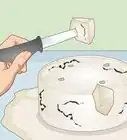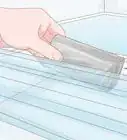This article was co-authored by wikiHow Staff. Our trained team of editors and researchers validate articles for accuracy and comprehensiveness. wikiHow's Content Management Team carefully monitors the work from our editorial staff to ensure that each article is backed by trusted research and meets our high quality standards.
This article has been viewed 49,501 times.
Learn more...
Aging cheese is an important step in its production that changes the cheese's flavor and texture. When you start the process of aging cheese, it's most important that the temperature and humidity level are at the proper setting. You can age cheese in a wine fridge, cellar, or regular fridge, though you'll have the best results using a mini fridge that you can easily control. Check your cheese often for signs of molding or dryness.
Steps
Choosing and Prepping the Storage Area
-
1Make sure the environment is clean and sanitized. If your cheese will be sitting on a shelf or in a drawer, clean the shelf or drawer thoroughly. You should also wash your hands before handling the cheese, or wear gloves to prevent bacteria from getting into it.[1]
- Check on the cheese’s environment often to make sure it’s still clean.
-
2Use a wine or mini fridge to control the temperature easily. These types of small fridges have a temperature control that you can use to easily adjust the temperature. Make sure you add a thermometer inside the fridge and fill a cup or jar half full with water before putting it in the fridge to help with the humidity levels.[2]
- You can use any normal thermometer, such as a meat or cheese thermometer.
- Look for mini fridges at a home goods or big box store, as well as online.
Advertisement -
3Put the cheese in a crisper drawer to use a regular fridge. While it’s more difficult to regulate the temperature and humidity in a normal fridge, it can be done if you check on the cheese regularly. Place the cheese in a sealed container in the crisper drawer and fill a small jar half full with water.[3]
- Clean the crisper drawer thoroughly with bleach before putting the cheese inside.
- If your drawer has adjustable temperature or humidity settings, change these to the warmest and highest settings.
- Check on your cheese daily in the crisper drawer to make sure there isn’t unwanted mold growing.
-
4Take advantage of a cool cellar to age the cheese. If you have a cellar with cool temperatures that are stable throughout the year, this can be a good place to age your cheese. Store the cheese in protected cabinets or plastic boxes, adding a damp paper towel for moisture. Open the cabinets or containers every day so that fresh air can reach the cheese.[4]
- When you put the damp paper towel inside the plastic box or cabinet, make sure it isn’t touching the cheese.
- Try using plastic boxes such as plastic tupperware or cake holders.
- Put the cheese on mats so that they’re not touching the bottom of the cabinet or plastic container.
Maintaining the Environment
-
1Maintain a constant temperature between 45–58 °F (7–14 °C). While the exact preferred temperature will vary depending on the type of cheese, it should stay within this range. Most normal refrigerators are colder than this, making it a better choice to use a fridge with an adjustable temperature device.[5]
-
2Set the humidity levels between 75 and 95%, depending on the cheese. The moisture level is important when aging cheese—if the humidity is too high, the cheese will grow mold, while if it’s too low, the cheese will dry out. Use a hygrometer to measure the humidity in the area where you’re storing the cheese.[6]
- You can find hygrometers at a big box store or home improvement store.
-
3Control the air ventilation to ensure the cheese has access to fresh air. You can do this by spacing the cheese evenly and away from walls or shelf sides. If the cheese is in a fridge, drawer, or cellar, make sure you open the door to the appliance or room’s door at least once a day so that fresh air circulates.[7]
- For example, if the cheese is placed on a shelf in a cellar, make sure the sides of the cheese are at least 1–2 inches (2.5–5.1 cm) away from the wall or other cheeses.
-
4Check on the cheese daily for necessary maintenance. Some cheeses will need to be flipped or wiped every day, so check the recipe for specific instructions. It’s also important to check on the cheese daily to make sure there aren’t any unwanted molds growing.[8]
- If there is unwanted mold growing, wipe it off with a clean rag dipped in white vinegar.
-
5Use vinegar to remove unwanted mold, if necessary. If your cheese starts growing mold that you want removed, dip a cloth or towel in white vinegar. Rub the cheese with the vinegar to remove the mold and help prevent cross contamination.[9]
- Rub all of the cheese with the white vinegar, not just the spot with mold.
Warnings
- Always use bleach and water solutions to sanitize all surfaces, containers, and tools to avoid mold and allergen growths. Wash your hands before working with any cheeses or tools to maintain sanitary conditions.⧼thumbs_response⧽
- Aging specialty and exotic cheese, such as blue cheese, can be more difficult than aging standard cheese. Prepare for a steeper learning curve and start with small batches.⧼thumbs_response⧽
- Strange odors, mold, or excess liquid should all signal that something has gone wrong and the cheese should be thrown out.⧼thumbs_response⧽
Things You'll Need
- Cheese
- Thermometer
- Hygrometer
- Air ventilated-area
- Bleach
- Paper towels
- Proper storage option
- Cup
- White vinegar
References
- ↑ http://www.cheesemaking.com/learn/how-to/make-a-cheese-cave.html
- ↑ https://www.culturesforhealth.com/learn/cheese/storing-aging-homemade-cheese/
- ↑ https://www.culturesforhealth.com/learn/cheese/storing-aging-homemade-cheese/
- ↑ http://www.cheesemaking.com/learn/faq/aging-cheese.html
- ↑ http://www.cheesemaking.com/learn/how-to/make-a-cheese-cave.html
- ↑ https://curd-nerd.com/aging-homemade-cheese/
- ↑ https://curd-nerd.com/aging-homemade-cheese/
- ↑ https://curd-nerd.com/aging-homemade-cheese/
- ↑ https://www.culturesforhealth.com/learn/cheese/storing-aging-homemade-cheese/
About This Article
To age cheese, put it in a sealable container and place it in the crisper drawer in your fridge. Place a small jar filled with water in the drawer with the cheese to prevent it from drying out. Set your crisper drawer to the warmest setting and check on the cheese daily to make sure there isn't any mold growing on it. If you find mold, just wipe it off with a clean rag dipped in white vinegar. To learn other ways you can age cheese, like in a wine fridge, keep reading!
